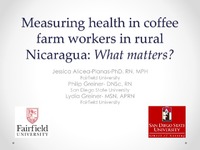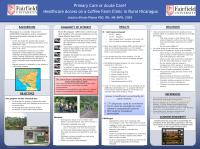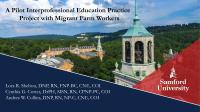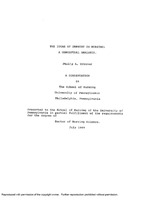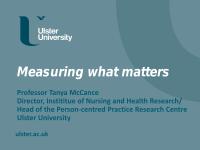| dc.description.abstract | <p>Session presented on Monday, July 27, 2015:</p>
<p><strong>Purpose:</strong> Nicaragua is a country with nearly 6 million inhabitants and is considered the second poorest country in Latin America. In Nicaragua, rural areas contain 45 % of the country's population, yet 65% of the poor and 80% of the extreme poor live in these areas. The average expenditure for the urban poor is 11% below the poverty line, while the rural poor are 37% below. The Nicaraguan poverty profile also demonstrates major regional disparities, with areas like Jinotega (north central area) being disproportionately affected by extreme poverty (World Bank, 2008). Rural poverty is often more profound than urban poverty, with rural communities facing multiple challenges which may put them more at risk for negative health outcomes. Stressors include inhospitable physical terrains, inadequate infrastructure on many roads, sparse electricity, and often unreliable water sources. Migrant and non-migrant agricultural farm workers are considered vulnerable populations with limited access to appropriate care (WHO, 2008). Migrant workers, especially, are considered a marginalized population and may face an assortment of health challenges like infectious diseases, chemical and pesticide related illnesses, heat related illnesses, traumatic injuries, poor dietary options, respiratory conditions and mental illness (Hansen & Donohoe, 2003). Health screenings and health promotion were identified as a needed/missing services by the on-site nurse at two rural coffee farms in Nicaragua.This purpose of this presentation will be to describe health-related factors in coffee farm workers (migrant and non-migrant) in rural Nicaragua. Current data (hypertension, blood glucose and BMI) and areas for health promotion are explored in this rural population, of which little is currently known.</p>
<p><strong>Methods:</strong> The study was conducted at 2 neighboring coffee farms in north central Nicaragua. Free health fairs were held during one week in January, 2014. All workers (migrant and non- migrant) were invited to attend. Demographic characteristics, access to health services, self-rated health and specific lifestyle factors were measured using selected items from the Central American Diabetes Initiative (CAMDI) survey. Additional data included blood pressure, blood glucose, height and weights, collected by senior US nursing students completing a public health nursing clinical rotation.</p>
<p><strong>Results:</strong> A total of 256 people participated in the fairs/screenings. The participants ages ranged from 18-75, 52% were male and 76% had either no formal schooling or only completed the primary grades. Nearly 76 % of the sample had never had their blood sugar tested (FBS ranged from 62-548 mg/dl) and 30% had never had a blood pressure check (SBP range from 90 ??? 172; DBP range from 52-120). Complete data was available on 212 workers. Correlation and multiple regression analyses were conducted using SPSS v 21 to examine the relationship between self-rated health and various potential predictors. Self-rated health was significantly correlated with sex, age, days missed due to illness, days worked sick, glucose, blood pressure (SBP and DBP), BMI, 'lifestyle factors' (smoking, salt intake and education level) and environmental factors (what farm the live on and whether or not they are migrant workers). The multiple regression model with all of these predictors produced R2 = .166, F (13, 181) = 2.77, p < .001. Only age, days worked sick, glucose and systolic BP were significant.</p>
<p><strong>Conclusion:</strong> There is limited information available on the health of rural coffee farm workers in Nicaragua. These data would suggest that as age, days worked sick, and glucose increase, self-ratings of health decrease. Next steps would include investigating what constitutes 'sick' in the context of these farm workers. In order to maintain a community based participatory research methodology, exploration would include follow-up interview questions or focus groups to elicit more information regarding standard diets and care for patients who work on coffee farms and live with diabetes. Since most meals are prepared on-site and provided to the workers for free, potential health promotion could center on food modifications at these meals and a broader range of healthy foods for purchase at on-site bodegas. Such changes would require education and negotiation with the farm administrators.</p> | en |
